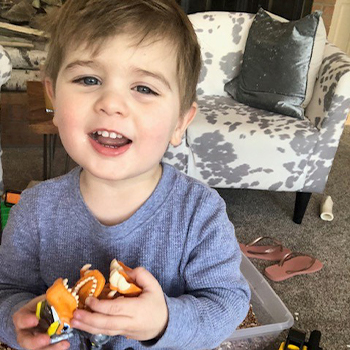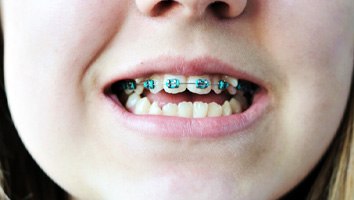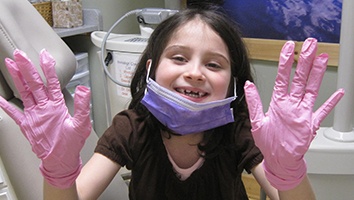PHASE ONE PEDIATRIC ORTHODONTICS – ROCHESTER, NY | WEBSTER, NY
Giving Little Smiles a Strong Start
 Dr. Drabik and our team enjoy helping little smiles shine. We offer an approach to treatment specifically designed to help children dealing with the earliest stages of orthodontic issues: phase one pediatric orthodontics in Rochester, which is also known as phase 1 orthodontics or interceptive orthodontics. We can start treatment early with conservative strategies, whether that is through braces or other orthodontic accessories. The goal of phase one orthodontics is to guide the development of the oral structures and prevent the need for more extensive treatments down the road.
Dr. Drabik and our team enjoy helping little smiles shine. We offer an approach to treatment specifically designed to help children dealing with the earliest stages of orthodontic issues: phase one pediatric orthodontics in Rochester, which is also known as phase 1 orthodontics or interceptive orthodontics. We can start treatment early with conservative strategies, whether that is through braces or other orthodontic accessories. The goal of phase one orthodontics is to guide the development of the oral structures and prevent the need for more extensive treatments down the road.
Why Choose Drabik Orthodontics for Phase One Pediatric Orthodontics?
- Orthodontist with more than 20 years of experience
- Kind, compassionate, & knowledgeable team
- Designed to help prevent issues before they start
Does My Child Need Phase One Orthodontics?

Your family dentist or pediatric dentist should take note of any indications that your little one may need orthodontic care, and they can make the proper referrals. (Your child’s regular dentist is likely quite skilled, but there is nothing wrong with proactively scheduling an orthodontic consultation for your child.)
You should also keep an eye on your child’s oral development. Here are some indications that they may need phase 1 orthodontic care in Webster:
- They have crowded, crooked, or gapped teeth.
- They have protruding teeth.
- Their top and bottom teeth do not fit together correctly (in other words, they have a bad bite).
- They have habits that could affect their dental development, such as vigorous thumb sucking or forward tongue positioning.
- It is challenging for them to clearly pronounce certain sounds.
- They have breathing problems, whether it is during the day or while they are asleep.
- Their jaw does not seem to be proportionate with the rest of their head.
- Their incoming adult teeth seem to be obstructed by their baby teeth.
HOW PHASE ONE PEDIATRIC ORTHODONTICS WORKS

Phase one pediatric orthodontics has one basic goal: fix misalignments in erupting permanent teeth and developing jaws to ensure the permanent teeth have enough room to come in straight. To do this, we recommend that parents bring their children in for a complete orthodontic screening by the age of seven. At this age, Dr. Drabik will be able to assess the health of their remaining baby teeth and developing adult teeth, as well as evaluate any potential developmental concerns.
If Dr. Drabik sees any issues, he may recommend limited orthodontic appliances that will help guide the growth the growth of your child’s oral structures. Phase one orthodontic treatment usually lasts less than one year, after which our team will reexamine your child’s mouth and determine if they could benefit from phase two orthodontic treatment in Gates, which usually involves full braces or clear aligners. It usually takes place a few years after phase one treatment is complete.
THE BENEFITS OF PHASE ONE PEDIATRIC ORTHODONTICS

Some noteworthy benefits of phase one orthodontics include:
- It is able to correct crooked, crowded, and gapped erupting permanent teeth.
- It can help to lessen or eliminate alignment issues with the erupting adult teeth.
- It guides the proper development of the teeth and jaws.
- It can drastically decrease a child’s need for more extensive orthodontic treatment in the future. In some cases, it can even prevent the need for future surgery.
- It can help improve various aspects of oral function, including speech, chewing, and breathing. In fact, it may even reduce or eliminate sleep apnea in children.
- It can help children stop habits that could lead to future orthodontic issues, such as thumb sucking and tongue thrust.
Why Your Child Should See an Orthodontist by Age 7

The American Association of Orthodontists recommends that all children have an orthodontic consultation before they turn 7 years old. This recommendation stands even if a child’s pediatric dentist or family dentist has not noticed any obvious orthodontic issues. In some cases, there are subtle issues with the development of the teeth and jaws that only an orthodontist is qualified to recognize and treat.
If you wait too long to schedule your child’s first orthodontic appointment, they could miss out on the opportunity for early treatment, which could complicate their oral health down the road. Of course, not all kids need phase one orthodontic treatment. It is entirely possible that Dr. Drabik will determine that no action is necessary, either now or in the foreseeable future.
COME SEE US!

If your child is approximately seven years old or if you can tell they already have some orthodontic concerns (crooked teeth or problems with their bite), we recommend you schedule an appointment with Dr. Drabik. They will know exactly how to make sure your little one stays comfortable and that you completely understand their needs. To schedule their consultation with our orthodontist near North Chili, contact us today!
Phase 1 Orthodontics FAQs

Our experienced team is eager to help your child’s smile thrive! Before you come in to see us, though, you might have questions about the road ahead. To help you out, we have put together a list of answers to some FAQs about phase 1 orthodontics. If you do not see the answers to your specific questions, reach out to us. We will be happy to personally assist you.
When Does Phase 1 Orthodontics Take Place?
Phase 1 orthodontic treatment, which is also known as interceptive orthodontics, usually occurs when a patient is between 6 and 9 years of age. This age range is when children usually start to lose their baby teeth and develop their permanent dentition. It is during this window that we have a golden opportunity to guide jaw growth and the eruption of adult teeth.
Because timing plays an important role in phase 1 orthodontics, we strongly urge parents to bring their children in for a consultation before they turn 7.
What Appliances Are Used in Phase 1 Orthodontics?
Phase 1 treatment is usually less complex than orthodontic care for adolescents and adults, so it often uses simpler devices. For example, if a child has overcrowding in their upper dental arch, we may recommend the use of a palatal expander, which can encourage the upper jaw to widen. If a child loses a baby tooth too early, we can use something called a space maintainer so the other teeth do not drift out of place and interfere with incoming adult teeth.
Phase 1 orthodontics does not usually require braces, but they are necessary in some cases of severe misalignment.
After the completion of phase 1 treatment, your child will need to wear a retainer so their teeth do not drift back out of place.
Is Phase 1 Orthodontics Painful?
We understand that, as a parent, you are deeply concerned about your child’s comfort. You can rest assured that the placement of orthodontic appliances is usually painless. However, some discomfort is normal as a patient adapts to their new oral device. Over-the-counter pain relievers, cold compresses, and a soft diet can help to minimize pain. Severe pain is a reason to call our office.
Does Phase 1 Orthodontics Affect Diet and Nutrition?
If your child has a removable appliance, they should take it out of their mouth at mealtimes. Then, they will be able to eat normally without any dietary restrictions. On the other hand, if the appliance is something like braces or a palatal expander, some adjustments to your child’s eating habits might be necessary. For example, they might need to stay away from hard and tough items, like nuts and raw veggies. A softer diet would be ideal.



